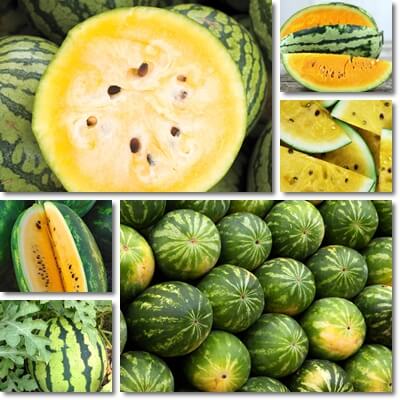Yellow watermelon is a variety of watermelon with yellow flesh. It’s perfectly edible and just as healthy and good for you as other watermelon colors. It can be used in the exact same way as pink and red watermelon and provides a host of benefits for skin, eyesight, blood pressure and the heart, as well as antiaging and anti-inflammatory benefits. What makes yellow watermelon yellow inside is a high content of yellow pigmented antioxidants called xanthophylls, known for reducing age related macular degeneration and cataract risks.
Can you eat yellow watermelon?
Yellow watermelon is perfectly safe to eat. Not just that, but it’s also good for you. You can eat yellow watermelon just as you would all other watermelon colors, including pink, red, dark red, salmon or orange watermelon. The fact that is has a different color inside does not indicate anything bad about it. On the contrary, colorful foods such as yellow-fleshed watermelon are healthy and provide a host of health benefits for skin, eyesight, the heart and the immune system.

Where does yellow watermelon come from?
Yellow watermelon actually precedes the more common pink and red varieties and was, in fact, the starting point for modern day pink and red watermelons. It’s not a new variety, just less common (although it’s not that rare in some parts of the world as it is in the West). The original watermelon presumably had a hard, green flesh and a bitter taste, but was brought into cultivation and crossed until it developed a soft, juicy, sweet flesh with a more appealing color.
One of the first colors to have been obtained was yellow and, from there on, farmers built up towards pink and red.
Is yellow watermelon a hybrid?
All the different types of watermelon we have today, including yellow, orange, pink and red-fleshed watermelons, are hybrids, having resulted from the crossing of two or more watermelon varieties sometime in the past. Modern watermelon colors, including yellow, were obtained over the course of generations by intentionally crossing fruits until certain characteristics were achieved. In the case of yellow watermelon, a juicy, flavorful, sweet-tasting watermelon fruit that is yellow inside.
Is yellow watermelon GMO?
Because their flesh color is such a novelty, people are wondering if yellow watermelons are genetically modified. They are in fact not. Yellow watermelon is non-GMO. It was obtained by intentionally crossing watermelon fruits with select characteristics until the current variety was obtained: a soft, juicy, crisp yellow-fleshed watermelon with a strong sweet taste with honey flavors. However, there are voices that say it could have been a natural mutation that arose by chance in the fruit and was subsequently picked up for cultivation.

What does yellow watermelon taste like?
While you can definitely come across a bland, flavorless or bad-tasting yellow watermelon, the variety is usually exquisite. Yellow watermelon has a sweet taste with deep, honey-like flavors and a fruity aroma. The flesh is soft, but crisp and juicy, a bit denser than that of red watermelon.
Discover more differences between yellow and red watermelon.
Why is yellow watermelon yellow inside?
What makes watermelon yellow inside is a high content of yellow pigments paired with a low content of red and orange pigments. The striking flesh color is a result of a high content of yellow antioxidants called xanthophylls, also found in egg yolk, chicken and duck fat, pumpkin, yellow carrots, yellow tomatoes, corn, marigolds and most green plants. Studies reveal the main pigment in yellow watermelon is neoxanthin, a yellow-pigmented xanthophyll and antioxidant. Xanthophyll pigments lutein and zeaxanthin, violaxanthin and neochrome also contribute to flesh color in yellow watermelon.
There are voices that say yellow watermelon is also an important source of beta-carotene, a red and orange pigmented carotenoid and antioxidant. Beta-carotene is the main pigment in orange watermelon and the second most common pigment in red watermelon after lycopene. Also find out why is watermelon red inside.
Is yellow watermelon healthy?
Yellow watermelon is just as healthy as pink, red, orange and other colors. One of the biggest benefits of eating yellow watermelon is a reduced risk of age related macular degeneration and cataract from yellow antioxidants called xanthophylls.
The fruit supports good vision, including color vision and night vision.
Yellow watermelon is especially good for skin, providing vitamin C to combat wrinkles for more youthful looking skin, vitamin A to support skin cell production and vitamin E from the seeds to help skin cells better retain moisture.
Eating yellow watermelon is good for gums and teeth thanks to vitamin C and small amounts of calcium, magnesium and phosphorus.
Find out more about the nutrition of yellow watermelon.
The fruit is sweet, easy to digest and hydrating, making a good food to eat for nausea and vomiting. It helps combat hypoglycemia by raising blood sugar levels, and is good for dehydration symptoms such as tiredness, fatigue, dizziness and headaches.
Eating yellow watermelon is good for high blood pressure, helping lower numbers, kidney function and the immune system. Low in calories and fat, it helps with healthy weight loss and effectively relives constipation as a result of its high water and good fiber content.
